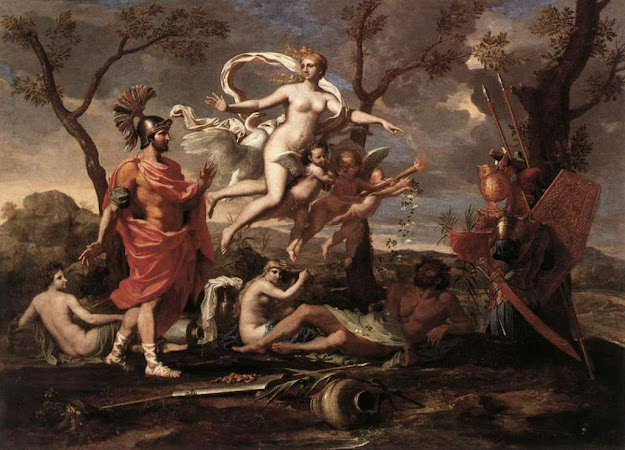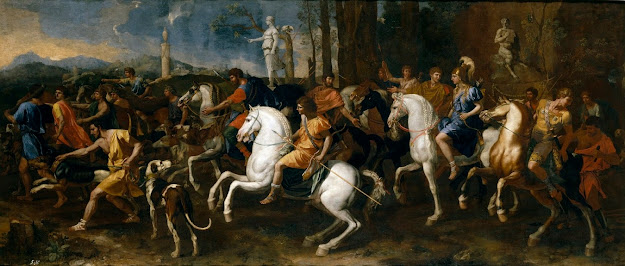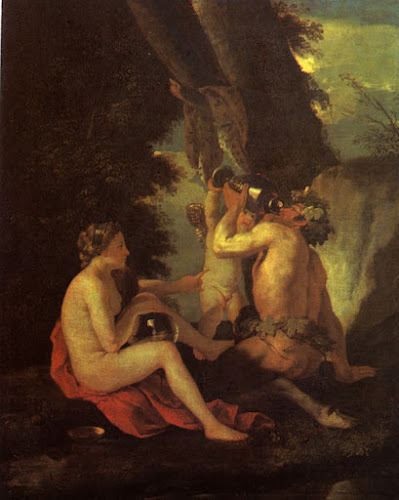 |
| Nicolas Poussin Landscape with Juno, Argus, and Io ca. 1635 oil on canvas Gemäldegalerie, Berlin |
HISTORY: Probably painted for the Marchese Vincenzo Giustiniani; in the inventory of his collection made in February 1638, after his death in December 1637; bought by the Kaiser-Friedrich-Museum with the Giustiniani collection in 1812.
"The Landscape with Juno, Argus, and Io is a direct development from the Numa Pompilius and must date from a few years later, about 1635. It is more symmetrical in its disposition of the trees, and the recession is more carefully worked out by means of the rocks in the foreground and by the river winding between clearly defined banks in the middle distance."
 |
| Nicolas Poussin Landscape with Juno, Argus, and Io (detail) ca. 1635 oil on canvas Gemäldegalerie, Berlin |
 |
| Nicolas Poussin The Nurture of Jupiter ca. 1636-37 oil on canvas Dulwich Picture Gallery, London |
HISTORY: Blondel de Gagny by 1757; Blondel de Gagny sale, Remy, Paris, 1776; Ogilvie sale, Christie, London, 1778 (as from the Blondel de Gagny collection), bought Campbell. Desenfans by 1804; at his death in 1807 bequeathed to Sir Francis Bourgeois, and by him in 1811 to Alleyn's College, Dulwich [whose art collection passed to the Dulwich Picture Gallery in 1817].
" . . . The Nurture of Jupiter at Dulwich [is] one of Poussin's most exquisite paintings for the delicacy of its formal harmony and the subtlety of its coloring, with its honey and aquamarine tones contrasted with a deep blue in the dresses of the nymphs. . . . The story is told by various ancient authors, but Poussin's most probable source is Callimachus (Hymn to Zeus). The motive of the goat Amalthea actually suckling the infant Jupiter is taken from an engraving by [Giulio] Bonasone after Giulio Romano. The general design and the pose of the nymph taking the honey from the tree are related to a medallion visible on a woodcut in the French edition of the Hypnerotomachia, published by Jean Martin in 1546."
 |
| Nicolas Poussin The Nurture of Jupiter ca. 1639 oil on canvas Gemäldegalerie, Berlin |
HISTORY: Possibly belonged in the late seventeenth century to Simon d'Imbert, Aix-en-Provence, or to Alexander Colbenschlag, Lyons, since the engraving after the picture by Guillaume Chasteau bears a dedication by the latter to the former. In the possession of Frederick the Great by 1786.
"The Berlin painting differs from the Dulwich version in that in the former the goat is milked by a satyr and the child drinks from a gilt jug. Further, the nymph takes the honey from the hive, as in the [Giulio] Bonasone engraving [after Giulio Romano], and not from the tree trunk. The theme of a satyr milking a goat is common in Italian bronzes of the sixteenth century."
"There is a similar reference to the idea of fertility in the twice-painted theme of the nurture of Jupiter, for the milk and honey are familiar symbols for this idea. Moreover, the story leads up to the invention of the cornucopia, which, according to some writers, was the horn of the goat Amalthea, who suckled the infant god."
HISTORY: According to the inscription on the engraving made by Francesco Aquila (active 1690-1740), the painting belonged at the time to the Principe di Cellamare at Naples. This would have been either Domenico Giudice (died 1718) or his son Antonio (died 1733). It is possible that the painting may have been commissioned by Nicolas Giudice, father of Domenico, who was created Principe di Cellamare in 1631. Passed by descent to the Duchessa di Cellamare, who had the picture in Rome about 1785-87. The Toronto picture had a label on the frame which said it had come from the collection of the Duke of Lucca; Duke of Lucca sale, Phillips, London 1841; Arthur Ledger, Sheffield; sold by him in 1945 to a dealer in Sheffield; bought from him by H. Barnes, Glasgow, who sold the picture to the Art Gallery of Ontario in 1948.
 |
| Nicolas Poussin Venus bringing Arms to Aeneas ca. 1636 oil on canvas Art Gallery of Ontario, Toronto |
HISTORY: According to the inscription on the engraving made by Francesco Aquila (active 1690-1740), the painting belonged at the time to the Principe di Cellamare at Naples. This would have been either Domenico Giudice (died 1718) or his son Antonio (died 1733). It is possible that the painting may have been commissioned by Nicolas Giudice, father of Domenico, who was created Principe di Cellamare in 1631. Passed by descent to the Duchessa di Cellamare, who had the picture in Rome about 1785-87. The Toronto picture had a label on the frame which said it had come from the collection of the Duke of Lucca; Duke of Lucca sale, Phillips, London 1841; Arthur Ledger, Sheffield; sold by him in 1945 to a dealer in Sheffield; bought from him by H. Barnes, Glasgow, who sold the picture to the Art Gallery of Ontario in 1948.
"In the Aeneas, Venus is no longer Ovid's goddess of love who appeared in the early paintings with Mars or Adonis; she is Virgil's goddess who, in the later books of the Aeneid, guides her son Aeneas, in the fulfillment of his destiny, to found the city of Rome. Moreover, the particular incident represented played an important part in this story, for it was by means of the armor made by Vulcan at the request of Venus that Aeneas was able to defeat Turnus in single combat and so establish himself on Italian soil."
HISTORY: Listed in the inventory of Landgraf William of Hesse in 1749. According to the Gallery catalogue, perhaps from the C.W. van Valkenburg sale, Willis, Rotterdam, 1731.
 |
| Nicolas Poussin Venus bringing Arms to Aeneas 1639 oil on canvas Musée des Beaux-Arts de Rouen |
HISTORY: Painted in 1639, and later belonged to Antoine Bouzonnet Stella; bequeathed to his niece, Claudine Bouzonnet Stella, and by the latter to her niece, Anne Molandier. Probably Prince de Carignan sale, Pailly, Paris, 1742; Robit sale, Paillet, Paris, 1801, bought Bryan; sold by him to Sir Simon Clarke; Clarke sale, Christie, London, 1840 (as from the Carignan and Robit collections), bought Nieuwenhuys; Lord Northwick by 1854; Northwick sale, Phillips, Cheltenham, 1859 (as from the Carignan, Robit and Clarke collections) bought Nieuwenhuys; Van Cuyck sale, Escribe, Paris, 1866 (as from the Carignan, Robit, Clarke and Northwick collections), bought by the Rouen Museum.
"During the last years of the 1630's Poussin seems to be moving toward a colder and more classical manner. The color becomes first blond in the paintings of 1636-37, and then almost gray in 1638-39. The forms become more monumental, as in the Berlin Jupiter, and finally almost frozen in their movements, as in the Rouen Venus, in which the goddess is a statue floating in the air almost without movement."
 |
| Nicolas Poussin Meleager and Atalanta Hunting ca. 1637-38 oil on canvas Museo del Prado, Madrid |
HISTORY: Probably Cassiano dal Pozzo. Spanish Royal Collection at Buen Retiro by 1701. A pair to the Dance in Honor of Priapus, now at São Paulo, which can be shown also to have been in the Spanish Royal Collection. They probably correspond to the Chasse and the Sacrifice mentioned in the account of Pozzo's collection in the papers of Robert de Cotte.
"The unusual size of the canvas and a certain dryness in the execution may give rise to some hesitation about the authenticity of the picture, but both it and its pendant are splendid designs, and the uncharacteristic features can be explained partly by the fact that Poussin was working on an unfamiliar scale, and partly perhaps on the hypothesis that he broke his normal rule and used assistants. . . . There is no information about the origin of the commission, and it is hard to believe that Pozzo would have ordered two such vast canvases for his house, which was not on a palatial scale. It may be tentatively suggested that they were painted for a patron who rejected them and perhaps bought partly out of kindness by Pozzo."
 |
| Nicolas Poussin The Choice of Hercules ca. 1636-37 oil on canvas National Trust, Stourhead, Wiltshire |
HISTORY: Probably the picture mentioned by [André] Félibien and Loménie de Brienne as having belonged to the lawyer Richaumont and then to his son-in-law, the architect François Blondel, who is mentioned in the 1684 edition of Brice as owning pictures by Poussin, but without details. Duke of Chandos sale, Cock, London, 1747, bought Sir Richard Hoare; passed by descent to Sir Henry Hoare, who gave Stourhead and its contents to the National Trust in 1947.
 |
| Nicolas Poussin Theseus finding his Father's Arms ca. 1635 oil on canvas Musée Condé, Chantilly |
HISTORY: John Knight by 1816 (lent to the British Institution); J. Knight sale, Phillips, London, 1821, presumably bought in; J. Knight sale, Phillips, 1839; E. Higginson sale, Christie, London, 1846 (as from the Knight collection), presumably bought in; E. Higginson sale, Christie, London, 1860, bought Cooper, presumably for Nieuwenhuys for the Duc d'Aumale; bequeathed by the Duc d'Aumale to the Musée Condé.
"The subject is taken from Plutarch. The idea of painting the theme may have been inspired by the account in Pausanias of a relief on the Acropolis representing the subject, which was all of bronze, except the rock, which was of marble. Mariette says that the architecture in the picture is by Jean Lemaire, who was a specialist in the painting of ruins and a close friend of Poussin. This would be in conformity with what is known of Lemaire's painting, but contrary to Poussin's general principle of not employing assistants. It is, however, possible, that in this case, as in the Dance in Honor of Priapus, there may have been some special reason which compelled him to adopt this course."
 |
| Nicolas Poussin Nymph, Satyr, Faun and Cupids ca. 1635 oil on canvas Gemäldegalerie, Kassel |
HISTORY: Listed in the inventory of Landgraf William of Hesse in 1749. According to the Gallery catalogue, perhaps from the C.W. van Valkenburg sale, Willis, Rotterdam, 1731.
"The painting in Kassel probably represents Amor vincit Panem. It shows a winged Cupid pushing a nymph on to the shoulders of a goat-footed figure, while a youth and a child prepare to accompany them. The goat-footed creature must be Pan, for the child carries the pipes and the bent stick, which are his attributes, and the authoritative gesture with which the nymph points the way indicates her power over him and his submission. She is therefore probably Venus, helped by her son, Cupid, to defeat Pan."
HISTORY: Probably the picture bought in Rome by the Abbate Flavio Ruffo for his brother, Antonio Ruffo, Duca di Bagnara, Messina, in 1647, and certified by Poussin as an original. Probably either Président Crozat de Tugny sale, Delatour, Paris, 1751, or Dufourny sale, Delaroche, Paris, 1819 (said to have been bought from Giovanni Pezzi in Rome about 1800). The Hermitage picture was bought from Korsakov in St. Petersburg in 1822.
 |
| Nicolas Poussin Nymph riding a Goat ca. 1636 oil on canvas Hermitage, Saint Petersburg |
HISTORY: Probably the picture bought in Rome by the Abbate Flavio Ruffo for his brother, Antonio Ruffo, Duca di Bagnara, Messina, in 1647, and certified by Poussin as an original. Probably either Président Crozat de Tugny sale, Delatour, Paris, 1751, or Dufourny sale, Delaroche, Paris, 1819 (said to have been bought from Giovanni Pezzi in Rome about 1800). The Hermitage picture was bought from Korsakov in St. Petersburg in 1822.
"It was probably in the mid-1630's that Poussin painted a group of small vertical compositions, all apparently dealing with the theme of love in a pseudo-allegorical manner. The meaning of one [directly above] is given by the group on the left, which repeats the winged putto defeating a goat-footed child of the Venus and Mercury. Evidently, the moral is the same, the victory of Eros over Anteros, a point that is emphasized by the fact that the principal figures are entirely human, whereas in others of the series the male figure is a satyr, and by the action of the flying putto who holds a goat – a well-known symbol of sensuality – by means of a chain of flowers, a gesture which implies the same meaning. In fact, the painting seems to be a sort of idealized epithalamion, with the flying cherub leading off the newly married couple."
HISTORY: Probably the picture seen by [John] Evelyn in the collection of the Comte de Liancourt in 1644. Jean-Baptiste Boyer d'Aguilles, Aix-en-Provence before 1705 (engraved by J. Coelemans in that year for the catalogue of Boyer's collection); Louis Lanthier, Aix-en-Provence (died 1737). Belonged in 1755 to Louis Antoine Crozat, Baron de Thiers; presumably inherited in 1750 from his elder brother, Louis François, Marquis du Châtel, who had inherited the collection formed by their uncle Pierre Crozat (died 1740). Bought with the Crozat collection in 1771 by the Empress Catherine II of Russia. Sent from the Hermitage to Moscow in 1930.
 |
| Nicolas Poussin Nymph with a Satyr Drinking ca. 1633-35 oil on canvas Pushkin Museum, Moscow |
HISTORY: Probably the picture seen by [John] Evelyn in the collection of the Comte de Liancourt in 1644. Jean-Baptiste Boyer d'Aguilles, Aix-en-Provence before 1705 (engraved by J. Coelemans in that year for the catalogue of Boyer's collection); Louis Lanthier, Aix-en-Provence (died 1737). Belonged in 1755 to Louis Antoine Crozat, Baron de Thiers; presumably inherited in 1750 from his elder brother, Louis François, Marquis du Châtel, who had inherited the collection formed by their uncle Pierre Crozat (died 1740). Bought with the Crozat collection in 1771 by the Empress Catherine II of Russia. Sent from the Hermitage to Moscow in 1930.
"The Moscow picture is less explicit, but the characters seem to be the same as the principals in the Kassel painting, and the manner in which Venus points to Cupid indicates that he is playing an important part in the story. . . . As with all Poussin's compositions of this type, it is uncertain whether the artist is merely depicting a group of sylvan figures, or whether there is some precise mythological reference. In some instances the female figures seems to be Venus, but here this is unlikely to be the case, as there would be no precedent for her to be depicted holding the flask of wine."
 |
| Nicolas Poussin Putti Fighting on Goats ca. 1629-30 oil on canvas private collection |
HISTORY: Archdeacon Cambridge sale, Christie, London, 1824; bought shortly before the Second World War by Christopher Norris. Mrs. Pascal (formerly Mrs. Norris) sale, Sotheby, London, 1951, bought Calman; bought from Calman by the present owner. . . . [What survives here is a] fragment of the original painting, now unfortunately cut down on all sides.
 |
| Nicolas Poussin Four Putti and Two Dogs ca. 1630 oil on canvas Hermitage, Saint Petersburg |
HISTORY: Almost certainly belonged to Cardinal Mazarin; presumably passed at his death either to Hortense Mancini, wife of the Duc de la Meilleraye, who became Duc de Mazarin, or to Filippo Mancini. Before the mid-1690's belonged to Etienne Texier de Hautefeuille, called the Commandant or the Bailli de Hautefeuille, who was Ambassador of the Order of Malta to the Court of France, and at his death in 1703 left his pictures to the Knights of Malta, who presumably sold them. Belonged in 1775 to Louis Antoine Crozat, Baron de Thiers, who in 1750 had inherited from his elder brother Louis François, Marquis du Châtel the collection formed by their uncle, Pierre Crozat (died 1740). Bought with all the pictures of the Crozat collection in 1771 by the Empress Catherine II of Russia.
 |
| Nicolas Poussin Putti Playing ca. 1630-33 oil on canvas Hermitage, Saint Petersburg |
HISTORY: Possibly the Bachanale de petits enfants which [Balthasar de] Monconys bought on 31.v.1664 from le sculpteur du Pape. This may be Bernini's assistant Carlo Matteo, who seems to have owned the Plague of Ashdod. Probably the petite Baccanale de petits enfants which is recorded by Le Maire as belonging to Colbert de Seignelay in 1685. Presumably passed to his brother and nephew. The Hermitage picture belonged in 1755 to Crozat de Thiers. Presumably inherited in 1750 from his elder brother, the Marquis du Châtel, who had inherited the collection formed by his uncle, Pierre Crozat (died 1740). Bought with all the pictures of the Crozat collection in 1771 by the Empress Catherine II of Russia.
"An allusion of a different kind to the idea of life after death is probably contained in the Putti Playing now in the Hermitage. The child in the foreground is catching a butterfly, which is a well-known ancient symbol for the soul, and the one next to him is holding a bird, which has a similar meaning. The putti themselves, moreover, implied for the ancients a reference to the afterlife and symbolize in their activities the delight prepared for those who in their life have been initiated to the Dionysiac mysteries."
– Anthony Blunt, Nicolas Poussin, (Phaidon Press, 1958) and The Paintings of Nicolas Poussin: Critical Catalogue (Phaidon Press, 1966)